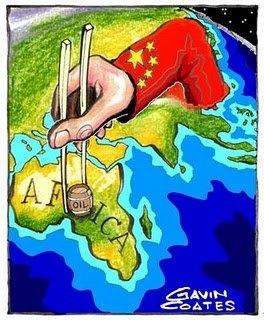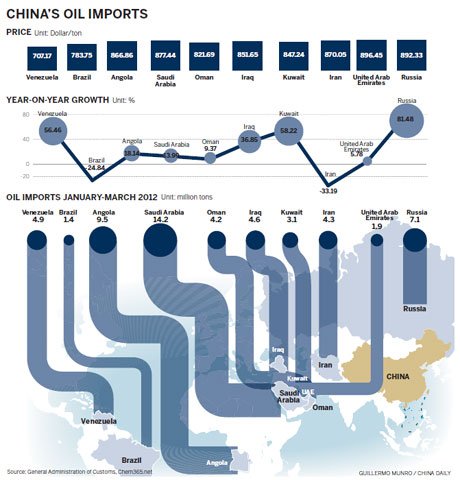'Angola model' as a Chinese investment strategy
‘Angola model’ as a Chinese investment strategy
In the last years the escalating Chinese infrastructural investments in Angola got significant attention. These investments aroused interest among scientists. After the examination we can determine that for the Chinese infrastructural investments have deeper interests than just develop the Angolan poor infrastructure conditions. The main purpose of these investment that to be able to obtain permission in order to be a part of the raw material extraction of the country after the extracted materials are export to China. This kind of Chinese infrastructural investment strategy we called ‘Angola model’. How do they really create, organise these investments and why this got the name of Angola model, I will explain these in the following paragraphs.

The Chinese and African countries relationships are determined by institutional arrangement of the host country especially what level of the democratic system and what level of the inclusive institutional system be there. For instance, Ethiopia has relatively democratic and inclusive institutional system in comparsion with other African countries, as a result the Chinese infrastructural investment inducted genuine economic development in Ethiopia like the Ethiopian-Djibouti railway project. However, in Angola the complete absence of the inclusive institutional system is experienced and the elite is intentionally maintain the weak democratic system along with serious social inequalities too. Furthermore, Angola has a huge amount of undigested raw material quarry especially crude oil. The combination of these two factors, the absence of the inclusive institutional system and the existence of the huge amount of raw materials provide that China be able to apply special investment strategies in some African countries that we call ‘Angola model’.
The Chinese relationship with Angola was created after the end of the civil war when Angola was needed significant material and political support because the civil war annihilated almost the total infrastructure of the country. Consequently, the Angolan government initiated the negotiations with the International Monetary Fund (IMF) to obtain remarkable grants. The IMF was ready to remittance the needed grants but only then if the government compliance the strict requirement of IMF like the enhance of transparency. According to the plans the government would had had to publicize the revenue from the sales of oil and the expenditures of government. IMF also demanded that the government create the stability of macroeconomic, shrinking the inflation and diminish the public expenditures. They insisted that the government especially address the elimination of the poverty and generally increase the wages. These requirements of IMF were completely opposite with will of the government of Angola. Therefore, many negotiation were failed but in 2003 both party were pretty close to the arrangement however in that year China got in touch with Dos Santos, the president of Angola and he started to the negotiations with the Chinese Ex-Im Bank about the credit terms. It quickly turns out that the credit conditions of the Chinese Ex-Im Bank were more auspicious for the elite of the host country, because China did not expect that Angola move forward to more democratic institution system like the requirement of IMF. In that situation China represented the “non-intervention policy” which does not expect any economic recovery strategy for the credit from the host country and this policy is the most auspicious for the Angolan elite. Due to the negotiations in 2004 the Chinese Ex-Im Bank transferred 4,5 billion dollars loan for the government of Angola. But it is important to note that credit was oil backed loan it means that if Angola will not be able to replay the loan it can replace the installment with crude oil export to China. The China-Angola economic relationship was generated with this loan arrangement as a result the Chinese special investment strategy, the Angola model can be stated.

The Chinese government shows a lot of interest to the national development programs, it means that China predilection finance and implements the investments that created within the framework of the national projects. – It was such a project the residential building construction strategy after the election of Dos Santos that purpose was to build 1 million flats. The Kilamba gated community was created within the framework of that project, according to the local public opinion it is a ghost city, because nobody lives there but China financed and implemented the construction. (Benazeraf et.al. 2014) – In most cases the Chinese Ex-Im Bank provides loans for the infrastructural investments and mostly these are raw material backed loans, after that generally a Chinese state-owned company implement the project. The Ex-Im Bank directly remittance the loan to the Chinese company (which carry out the project) to ensure their totally control of the project. The reason for that the Chinese bank try to alleviate risk of the loan with that to bypass the Angolan uncertain financial system. This kind of investment strategy ensure to China to be able to create and maintain a close economic relationship with Angola and to be able to enhance their interests in the oil fields. The purpose of Chinese investment strategies to intensify the political capital accumulation through to provide raw material backed loans to the host countries. The Angolan model, as a Chinese investment strategy are determined by three main component co-existence: (i) the degree of conditional investment risks, (ii) the availability of raw material to the source, (iii) and gaining political influence in the host country.
After the oil backed loan arrangement the Angolan government submitted public tenders for the construction projects, but the 70% of the winners were Chinese companies. The rest 30% of the winners were local companies in order to ensure the Angolan participation of the projects and probably to ensure the minimum proportion of the local workers on the projects, because there were serious demonstrations about the low local worker proportion of on the projects. Over the years China modified their investment strategy because they figured out in order to sustain their strategy they had to gain the focus to the capacity enhancement, training for the local workers. It is typical of the Angola model to mostly hire Chinese workers on the constructions so the local workers do not take advantage of each projects and also the most primary commodity are imported from China. However, we need to know that in the most host countries are absence of skilled workers but abundant in low skilled workers and in this part China could have intensify the proportion of the local workers. In most cases the host countries are absence of appropriate quality and quantity of primary commodity or supplier company therefore the high proportion of Chinese primary commodity and workers import in some cases is necessary.

I consider it interesting to present how China acquired influence on Angolan oil fields through the Angolan model. I have just been introduced Chinese infrastructure investments and loans granted proves for the Chinese companies to be able to acquire concession rights in the host countries. This is the most important driving force of the Angolan model to through the infrastructure investments the Chinese banks provide loans for developing countries and these loans are usually used by Chinese companies to be able to carry out the investment projects. As a result of these projects the Chinese companies successfully acquire concession rights for the mining of the host country’s raw materials or be able to acquire ownership some state-owned company which also deal with natural resourcing mining. The first such investment was executed in Angola in 2004 by the Chinese Sinopec Group. As a result of that this company acquired 50% ownership in the Angolan Block 18 oil field. The most interesting situation of the acquisition that this is coincide the first installment of the Chinese Ex-Im Bank 4.5 billion dollars loan that have provided formerly to Angola, but the Angola could not be able to pay this installment. Furthermore, formerly they have signed the agreement for this 50% ownership acquisition with the Indian ONGC Videsh oil company, but suddenly the Angolan government canceled this agreement and signed with the Sinopec Group instead of the Indian company. Then the Sinopec Group acquired newer exploitation rights in Angola so that the government did not extend the contract with the Total company. This acquisition also coincided statement of the Chinese Ex-Im Bank that the bank will proved 2 billion dollars credit line for the government for infrastructure investments. In fact, this was the first time when Chinese oil company entered into the Sub-Saharan region and probably the application of the Angolan model has contributed significantly to this. It is important to mention there is no direct proven relationship between the loans provided by Chinese Ex-Im Bank, the infrastructure investments and the Sinopec expansion but we can conclude that it has strong relationship.
It is visible, that the Chinese investment strategy is pretty complex and often impenetrable. Nevertheless, from the certain infrastructure projects and revealed loans can conclude that the main goals of these investments not just the development rather to be able to acquire concession rights for the natural resource mining and consequently be able to ensure the long-term profit. The presented Sinopec expansion on the Angolan oil fields is show that the Angola model as investment strategy could not be obviously identified. However, from other circumstances can conclude that this strategy was used by China to be able to reach their long-term goals. Ergo this kind of Chinese investment strategy got the name of Angola model because probably it was used at first in Angola in the African continent in order to China get concession right through the investment projects. However, China also use this Angola model in other African developing countries which have the similar institution system and possess huge undigested natural resources like Angola.
Sources:
• Lucy Corkin – Uneasy allies: China’s evolving relation with Angola, 2011 – Journal of Contemporary African Studies Vol. 29, No.2, April 2011, 169-180 http://www.tandfonline.com/doi/abs/10.1080/02589001.2011.555192?journalCode=cjca20
• David Benazeraf and Ana Alves - ‘Oil for Housing’: Chinese- built New Towns in Angola, 2014 – Policy Briefing 88, Global Powers and Africa Programme
http://dspace.africaportal.org/jspui/bitstream/123456789/34713/1/saia_spb_88_%20Benazeraf%20&%20Alves_20140416.pdf?1
Olá.
@gazetagaleguia pretende poñer en valor as persoas que falan arredor dos sitios que manteñen a fala portuguesa como parte do seu patrimoio.
Teu post foi mencionado na nosa revista de hoje
Obrigadas polas túas colaboracións
Hello there:
@gazetagaleguia wants valorize the people who speak in steemit from everywhere maintains the portuguese language.
Your post has mentioned in our today magazine
Thanks a lot for your contributions.
Thank you to mentioned my study in your magazine I really appreciate it.
This is one of the best feedback of my work.
Congratulations @szbence92! You received a personal award!
Click here to view your Board of Honor
Do not miss the last post from @steemitboard:
Congratulations @szbence92! You received a personal award!
You can view your badges on your Steem Board and compare to others on the Steem Ranking
Vote for @Steemitboard as a witness to get one more award and increased upvotes!